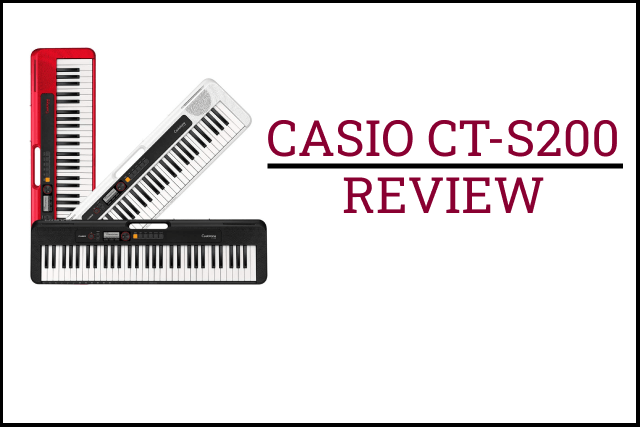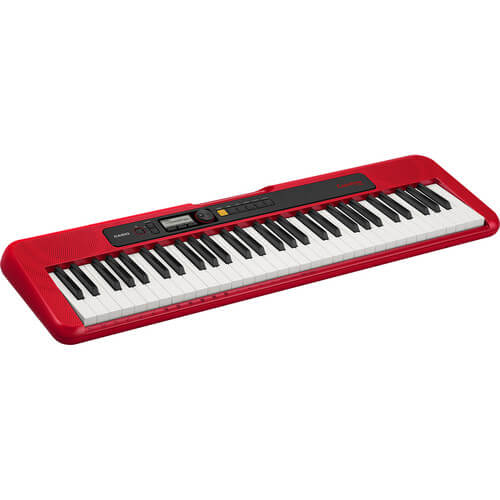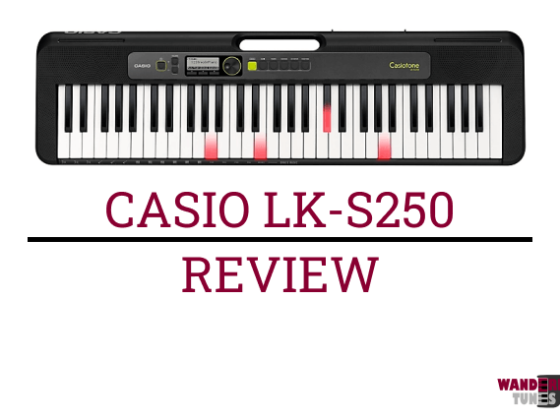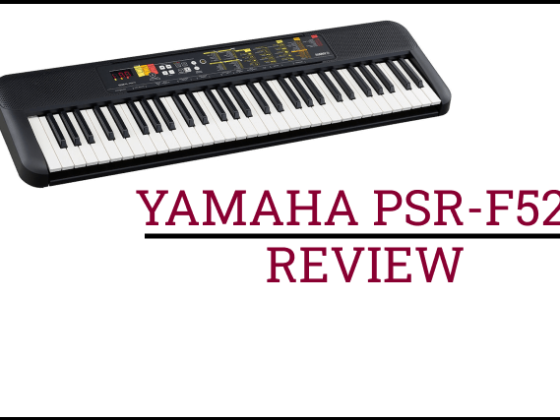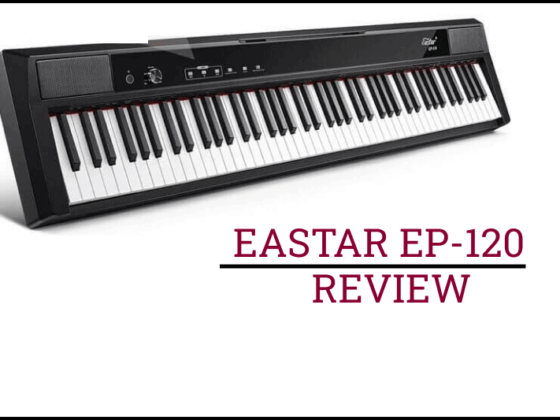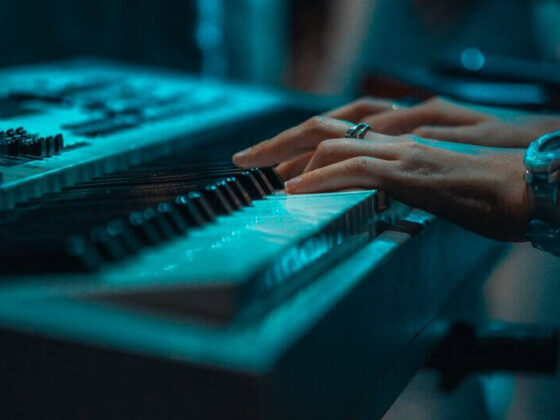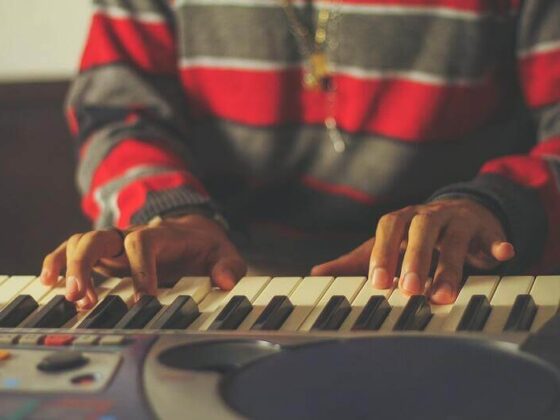CT-S series is Casio’s more recent introduction to the market, which shares the same name as the company’s first keyboard series. These keyboards are geared toward beginners and were made to be inexpensive and simple to use.
Overall, Casio CT-S200 stands out with its affordable price and the plethora of features it offers. The MIDI compatibility in the Casio CTS-200 feature also makes it a great choice not only for beginners but any musician.
But, who is this keyboard best for? How does it compare to other alternatives?
I’ll try to give my honest thoughts in this in-depth review.
Pros And Cons
Pros
- Lightweight and incredible portability
- MIDI connectivity
- Compatible with the Chordana Play App
- 400 built-in sounds, 77 accompaniment rhythms, and 60 songs
- Different color options that look spectacular (black, white, red)
- Great value for money
Cons
- Keys are not touch-sensitive
- No pitch bend wheel
Design
Overall, the CT-S200 has a very clean layout with a few buttons and an LCD screen on the front panel. In fact, the layout is so clean and easy to use that you will likely be able to operate all the buttons without needing to look at the manual.
Weighing only 7.3 lbs (3.3 kg), Casio CT-S200 is an extremely lightweight keyboard that even a little child can easily carry. If you are looking for a portable keyboard to take to music lessons or travel with, this instrument is a perfect choice.
I think Casio’s entry-level keyboards really stand out with their portability features. One of my favorite features of the CT-S200 is its built-in carry handle which makes moving the instrument ridiculously easy. With the carry handle, it really feels like you’re carrying your everyday bag, not a 61-key instrument.
As if these weren’t enough, the CT-S200 can run on 6 X AA batteries should you wish to play outside and you don’t have access to an outlet.
What is unique to this model is that it is available in 3 colors: black, white, and red. I think the red one looks incredibly stylish and that’s the one I would go with.
For the price point, I’m extremely surprised at the build quality of this keyboard. Most keyboards at this price point feel like toy pianos because of the cheap plastic and glossy feeling of their keys. Despite the price, Casio CT-S200 doesn’t feel like a cheap piano at all. The build quality is decent and the keyboard itself feels very solid.
Casio CT-S200 doesn’t come with a keyboard stand. You can check out these bundles on Amazon that feature a stand and other additions you might need.
Keys
Casio CT-S200 features 61 full-size standard keys. The keys aren’t weighted, but at this price, it is hard to find a proper keyboard with weighted keys. Still, the keys of the CT-S200 feel quite decent and have a nice feeling while playing, unlike other cheap keyboards at a similar price point.
The keys aren’t touch-sensitive, making this keyboard best for beginners or those who want to use it as a midi controller. If you want touch-sensitive keys, you can look into CT-S200’s big brother, Casio CT-S300. For $40 more, you get velocity-sensitive keys and a pitch bend wheel, which is worth considering.
Alternatively, you can check out Casio LK-S250, which also costs $40 more but features touch-sensitive and light-up keys for easily learning songs.
If you’re on a budget, you can also check this post where I reviewed the 10 best cheap 88-key keyboards and digital pianos.
Sounds
The CTS200 produces a thrilling sound that defies its small size by utilizing an entirely new speaker design and unique equalization technology.
In addition, with an impressive library of 400 built-in sounds, 77 accompaniment rhythms, and a bank of 60 songs, the CT-S200 opens up a lot of room for creativity. A wide variety of voice and rhythm options will keep beginners and kids entertained.
As expected with so many sounds available, tones except the pianos, electric pianos, and strings are not the most realistic. However, I believe most players won’t use the sounds except the pianos or strings very often, which sound very decent. The other sounds, on the other hand, will be more than enough for occasional improvisational playing here and there.
Having 10 different reverb types in such an affordable keyboard is quite surprising, to be honest. This setting will allow you to design sounds and depth to your liking, which is my favorite function in keyboards and digital pianos.
48 notes of polyphony in this keyboard will be sufficient for beginners.
Speakers
There are 2W speakers on each side (2W + 2W), which is quite sufficient for most people. If you want to play gigs or perform in a large room, there is an option to plug into an amplifier.
Despite not being super powerful, the speakers are of very decent quality. Even at the loudest volume, there isn’t any distorted sound. The sound is very clear and bright.
Features
One Touch Preset
When you are experimenting with rhythms, the One Touch Preset instantly selects the best sound for the rhythm you have chosen. To be honest, I’m pleasantly surprised that we have this feature at this price point.
Chordana Play App
Notably, the CTS200 works with the Casio Chordana Play app, giving users access to 50 in-app demo tunes and downloadable MIDI files. With this feature, beginners can enjoy learning their favorite songs and improve their playing in a fun way.
Dance Music Mode
You can easily play and enjoy dance music by fusing bass, synthesizer, and drum phrases in this mode. Remix existing EDM songs or make your own.
In the video down below, you can see how it works. Although it is not a must for a keyboard, it is a great bonus for beginners and can add to their enjoyment of the instrument.
My Setup Button
You may store your preferred settings using the My Setup Button, which is a really helpful feature when you have established your ideal tone and rhythm and don’t want to start over every time.
Casio CT-S200 VS Casio LK-S250
Casio CT-S200 and Casio LK-S250 are among the most popular entry-level keyboards. Both have the same library of voices, rhythms, and songs. Their designs are almost identical with the same weight and portability features.
The main difference between the two is that Casio LK-S250 has a key lighting system that helps beginners learn new songs quickly in a fun way. In addition, the keys of LK-S250 are touch sensitive. Finally, the LK-S250 offers an extra microphone input for those who want to sing along, which is missing in the CT-S200.
On the other hand, Casio CT-S200 comes in 3 colors, while LK-S250 is only available in black.
In summary, the $40 difference gets you a keyboard with lighted and touch-sensitive keys as well as a mic input but no color option to choose from. I would always prefer touch sensitivity for a more realistic piano-playing experience, but it may not be necessary in your case.
If you still can’t decide, you can read my full review of the Casio LK-S250 here.
Casio CT-S200 VS Casio CT-S300
Belonging to Casio’s same product line-up, both Casio CT-S200 and CT-S300 are designed with beginners in mind. Both are affordable, have the same sound and rhythm library, and are easy to carry.
I believe the most notable difference why you may want to prefer the Casio CT-S300 over the S200 is that it is equipped with touch-sensitive keys, which justifies the price difference. In addition, Casio CT-S300’s speakers are slightly more powerful (2.5W + 2.5W) than the CTS-200 (2W + 2W), though I don’t think it’s a remarkable difference if you are going to use it mainly for practicing.
The pitch bend wheel in the Casio CT-S300 is not available in the CT-S200, but again, it’s not going to make a big difference for most beginners.
Regarding color options, Casio CT-S200 wins one more time with 3 beautiful color options, while CT-S300 only comes in black.
Casio CT-S200 VS Yamaha PSR-F52
While both Casio CT-S200 and Yamaha PSR-F52 have similar prices and are aimed at beginners, I would recommend Casio CT-S200 for a number of reasons.
First, there is no midi compatibility in the Yamaha PSR-F52, meaning that it misses out on a lot of learning opportunities for beginners. In addition, the glossy plastic keys don’t feel and look natural compared to the CT-S200. There are also a lot fewer sound options to choose from in the PSR-F52, though the tones sound more expressive due to the better sampling technology used in the Yamaha.
When it comes to portability, the PSR-F52 weighs less, but I think the built-in carry handle in the Casio CT-S200 makes it more portable and convenient to carry than the Yamaha PSR-F52. Finally, the Casio CT-S200 features 48 notes of polyphony compared to the 32 notes in Yamaha.
However, Yamaha PSR-F52 boasts more powerful speakers with 2.5W speakers on both sides, which is another upside.
You can also check out my in-depth review of the Yamaha PSR-F52 for more information.
Conclusion
At such a low asking price, Casio CT-S200 offers plenty of features that I was surprised to see. From the rich sound library to MIDI connectivity, this keyboard is packed with great features that are hard to find in similar budget keyboards. In this regard, Casio CT-S200 is an incredible value for the money.
I hope you have found this Casio CT-S200 review helpful. If you have any comments or questions, I’m happy to answer them in the comments below!

